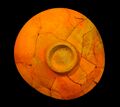NO·8
| Inscription | |
|---|---|
| Reading in transliteration: | rikanas |
| Reading in original script: | |
|
| |
| Object: | NO·8 Oleggio (bowl) |
| Position: | bottom, outside |
| Orientation: | 0° |
| Direction of writing: | dextroverse |
| Script: | North Italic script (Lepontic alphabet) |
| Number of letters: | 7 |
| Number of words: | 1 |
| Number of lines: | 1 |
| Workmanship: | scratched after firing |
| Condition: | complete |
|
| |
| Archaeological culture: | unknown, La Tène D [from object] |
| Date of inscription: | last quarter of 2nd c. BC [from object] |
|
| |
| Type: | unknown |
| Language: | Celtic |
| Meaning: | 'of Rikana' |
|
| |
| Alternative sigla: | Morandi 2004: 84 |
|
| |
| Sources: | Morandi 2004: 577 f. |
Images
Commentary
First published in Gambari 1989. Examined for LexLep on 24th April 2024.
Images in Gambari 1989: 196 (photo = Gambari 1999: 392, fig. 416 = Morandi 2004: 789, tav. XII.84), Deodato & Poletti Ecclesia 1999: 114, fig. 95.15 (drawing = Gambari 1999: 393, fig. 417.5), Morandi 1999: 184, fig. 6 (drawing = Morandi 2004: 576, fig. 13.84).
Inscribed on the bottom of the patera near the rim, following a concentric line as upper guideline. The form is an ā-stem in the genitive. Gambari (also 1999: 388 f., no. 5) has interpreted the form as lexical 'queen', i.e. an inscription 'of the queen' on a vessel of civil or sacral ritual significance. He argues that this interpretation is confirmed by the typology of the grave – a female burial with weapons indicating social status – as well as other allegedly lexical attestations of rix° such as the coin legend NM·5 rikoi, and rik beside another inscription in a grave at Gottolengo (see BS·9, BS·10). While the context of the attestation of rikanas is certainly suggestive, the identification of an Insubrian political position and ruler's title rīgos/rīganā is not compelling; neither is the grammar, the Gaulish word for 'queen' being the ī-stem rīganī (see the word page). Though rigana is indeed not attested as a personal name in Continental Celtic, a personal name is typologically much more likely; cf. Motta 1992: 317 ("transposition en nom propre (tout comme pour l'italien Regina) du mot gaulois rīganī"), Morandi 2004: 578. Cf. also Morandi 1999: 184 f., no. 33, who notes the poor quality of the patera, which is distorted from a not entirely successful firing process, and also of the two vessels bearing the inscriptions rik (BS·9, BS·11) at Gottolengo.
Bibliography
| Deodato & Poletti Ecclesia 1999 | Angela Deodato, Elena Poletti Ecclesia, "Catalogo", in: Giuseppina Spagnolo Garzoli (ed.), Conubia gentium. La necropoli di Oleggio e la romanizzazione dei Vertamocori. Catalogo della mostra Oleggio, Palazzo Bellini 23 gennaio - 30 aprile 1999, Torino: Soprintendenza per i Beni Archeologica del Piemonte 1999, 55–286. |
|---|



